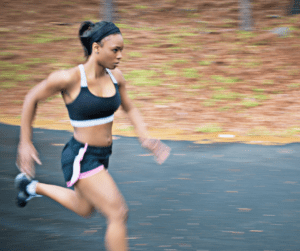
This has to be one of the most common questions we get – “How do I improve my pace?”
The answer to this seems to be the holy grail in most running circles.
Pace gives us an immediate sense of how long it takes to cover certain distances while running.
So… what can you do to improve your running pace? We’ll discuss the answer below…
The Best Way To Improve Your Running Pace
One of the best ways to improve your pacing is to… practice it.
Take note, we are not suggesting that you must run at the pace that is your goal.
There are a couple of avenues and I think it’s important to differentiate between different classes of running.
By that, I mean differentiating on ability – I’m talking more along the lines of experience.
Ability will come into it down the road. But, if you are still a relatively inexperienced runner… you’re still quite new to running, then running more within reason is still going to be your short-term best way and the lowest-risk way to improve your pace.
By increasing your aerobic base, you also land up strengthening your muscles, tendons, and ligaments that little bit more so that when you do introduce speed work further down the line, you have a much lower risk of injuring yourself.
In that sort of category of runners, so maybe you’ve even run a marathon and it’s your first marathon, but actually, it was the accelerated plan 0 to marathon in a year, you’re probably still better off just trying to get a little bit more consistent and get your running into a better groove.
Developing a better base before you start going into speed work is vital.

This is where you inject a little bit of pace and variety. But again, I use the word low risk so that we’re not pulling muscles or injuring knees, or picking up any running injuries.
For more experienced runners, where you’re perhaps going into your third or fourth marathon, or you’ve been running half marathons for a little bit of time, and find yourself stuck on a time.
That means that you’ve probably gotten to the stage where you’ve hit a plateau in terms of the kind of volume that you can handle and more volume over and above that then doesn’t go on to make you a better runner… it makes you more tired and more susceptible to injury.
This is the point where you will then start looking at some interval type of workouts to improve your running speed.
There is a huge array of ways of doing that. But for me, the safest way of doing that is to start by increasing strength – some of that could happen in a gym, but a lot of that can happen on the road by introducing some hill work.
There are two different types of strength. Both are equally important:
1) Strength as we know it, building lean muscle mass specific for running (can be done in the gym or at home).
2) “Running strength” as I like to call it, which we use hill repeats
Here at Coach Parry, we’re massive advocates of strength training. We’ve put together this free strength training plan for runners that you can do once a week, at home and with no expensive equipment needed. You can access it by clicking here.
To introduce hill work you should start with three or four reps of one-two minute (depending on ability and goal) of pushing yourself quite hard (key point, not maximal all-out effort, 7-8 /10) running up a hill and then a nice and easy jog down/walk down and build that up until you’re doing 6-8 reps of that.
After you’ve done that for four or five weeks, you would then look at shortening that and doing it for one minute, but now obviously you run a whole lot harder and you perhaps would do eight to 10 of those. (Note: This method is more of a focus on power vs strength)

That will make significant improvements in your speed and of course, then you can go on to things like speed endurance, and speed work.
A further progression is to do some sort of neuromuscular work, which is to say you do 100s, 200’s and 400s. Although when you start moving to that sort of area, it’s much better to be taking advice and to be in a coaching system or environment where somebody can talk you through that and make you do it all at the appropriate paces.
Over the last decade, we have worked with a number of professional runners and there are 8 things that they do consistently that most amateur runners don’t do.
Genetics plays a huge part in whether or not you’re going to be a world-class athlete, but anyone can do these 8 things and they will have a HUGE impact on your running and this will result in a massive improvement in your running pace.
I feel that it is important to reiterate that without a sound aerobic base, you are risking injury.
Let’s dive into the principle of how much high-intensity training you should be doing…
The 80/20 Rule
We often talk about running the easy runs easy enough so that you can run the hard runs hard enough but how much hard running should you be doing?
We’ve done a lot of studying around the theory of polarization in training.
The 80/20 principle is a method we use within our training, you should do 80% of your training at a low intensity and 20% or less at a high intensity.
The smaller the gap between your easy run intensity and your hard run intensity the more likely you are to plateau.
Let’s have a look at what 80/20 means in your weekly training schedule…
80 + 20 =100… in this instance, it’s not always that simple, but it doesn’t necessarily mean that that is what you should definitely be following, there are lots of different things that we need to take into account when looking at this.
For example, if you run eight hours a week that is essentially saying then an hour and a half of that should be high intensity and if you think about it that way… that is a lot of high-intensity training…
You also have to take into account if your high-intensity sessions are speed sessions or hill sessions. Both types should incorporate recovery time. So it’s not an exact 80/20.
Exceptions To The 80/20 Rule
There are a few exceptions to who should be doing less high-intensity, such as…
Runners over the age of 50, runners who are a lot less experienced, runners who are returning from an injury, and runners whose jobs involve a lot of physically intense work on their feet should cut the 20% right down to 10%. Meaning only 10% of their total training volume should be done at higher intensities.

An example of this would be doing a high-intensity session every second week or instead of doing a very hard high-intensity type of session every week, you might incorporate something like a three-mile or five-kilometer time trial, so it’s still hard but the volume of that effort is going to be lower than taking up 20% of your training.
Everyone needs to make sure they don’t do too much high-intensity training because it’s in our recovery process where we really adapt from our training sessions.
If we’re doing everything too hard or we’re running too hard too often we’re affecting the quality of our recovery which means that we won’t be able to do the next session which might be a quality session well enough as prescribed.




Comments are closed.